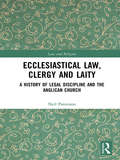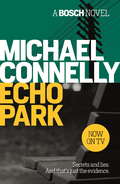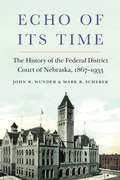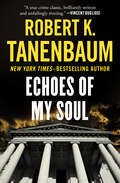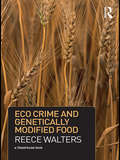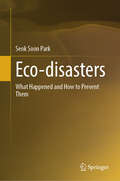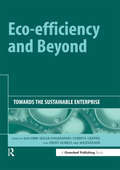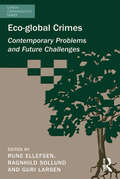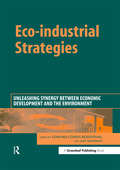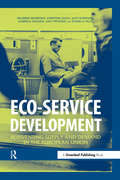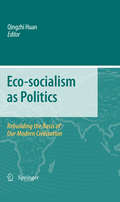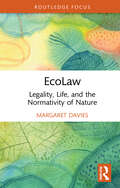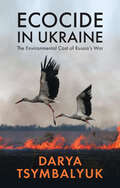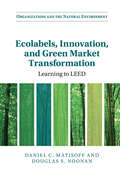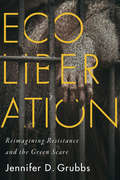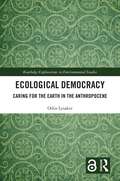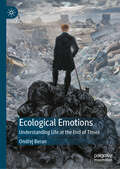- Table View
- List View
Ecclesiastical Law, Clergy and Laity: A History of Legal Discipline and the Anglican Church (Law and Religion)
by Neil PattersonDiscipline in an ecclesiastical context can be defined as the power of a church to maintain order among its members on issues of morals or doctrine. This book presents a scholarly engagement with the way in which legal discipline has evolved within the Church of England since 1688. It explores how the Church of England, unusually among Christian churches, has come to be without means of effective legal discipline in matters of controversy, whether liturgical, doctrinal, or moral. The author excludes matters of blatant scandal to focus on issues where discipline has been attempted in controversial matters, focussing on particular cases. The book makes connections between law, the state of the Church, and the underlying theology of justice and freedom. At a time when doctrinal controversy is widespread across all Christian traditions, it is argued that the Church of England has an inheritance here in need of cherishing and sharing with the universal Church. The book will be a valuable resource for academics and researchers in the areas of law and religion, and ecclesiastical history. .
Echo Park (Harry Bosch Series #12)
by Michael ConnellyLAPD Detective Harry Bosch in a modern thriller from No. 1 bestseller Michael Connelly - author of THE LINCOLN LAWYER and ANGELS FLIGHT.In 1993 Homicide Detective Harry Bosch was assigned the case of a missing person, Marie Gesto. The young woman was never found - dead or alive - and the case has haunted Bosch ever since.Thirteen years later, Bosch is back in the Open Unsolved Crimes Unit when he gets a call from the DA's office. A man accused of two killings is willing to confess to several other murders in a deal to avoid the death penalty. One of his victims, he says, is Marie Gesto.When investigating these previously unsolved crimes, Bosch begins to crack when he realises that he and his partner missed a clue that could have prevented the serial killer striking again.
Echo Park (Harry Bosch Series #12)
by Michael ConnellyLAPD Detective Harry Bosch in a modern thriller from No. 1 bestseller Michael Connelly - author of THE LINCOLN LAWYER and ANGELS FLIGHT.In 1993 Homicide Detective Harry Bosch was assigned the case of a missing person, Marie Gesto. The young woman was never found - dead or alive - and the case has haunted Bosch ever since.Thirteen years later, Bosch is back in the Open Unsolved Crimes Unit when he gets a call from the DA's office. A man accused of two killings is willing to confess to several other murders in a deal to avoid the death penalty. One of his victims, he says, is Marie Gesto.When investigating these previously unsolved crimes, Bosch begins to crack when he realises that he and his partner missed a clue that could have prevented the serial killer striking again.
Echo Park (Harry Bosch Series #12)
by Michael ConnellyLAPD Detective Harry Bosch in a modern thriller from No. 1 bestseller Michael Connelly - author of THE LINCOLN LAWYER and ANGELS FLIGHT.In 1993 Homicide Detective Harry Bosch was assigned the case of a missing person, Marie Gesto. The young woman was never found - dead or alive - and the case has haunted Bosch ever since.Thirteen years later, Bosch is back in the Open Unsolved Crimes Unit when he gets a call from the DA's office. A man accused of two killings is willing to confess to several other murders in a deal to avoid the death penalty. One of his victims, he says, is Marie Gesto.When investigating these previously unsolved crimes, Bosch begins to crack when he realises that he and his partner missed a clue that could have prevented the serial killer striking again.Read by Michael Brandon(p) 2006 Orion Publishing Group
Echo of Its Time: The History of the Federal District Court of Nebraska, 1867-1933
by John R. Wunder Mark R. SchererThroughout its existence the Federal District Court of Nebraska has echoed the dynamics of its time, reflecting the concerns, interests, and passions of the people who have made this state their home. Echo of Its Time explores the court’s development, from its inception in 1867 through 1933, tracing the careers of its first four judges: Elmer Dundy, William Munger, Thomas Munger (no relation), and Joseph Woodrough, whose rulings addressed an array of issues and controversies echoing macro-level developments within the state, nation, and world. Echo of Its Time both informs and entertains while using the court’s operations as a unique and accessible prism through which to explore broader themes in the history of the state and the nation. The book explores the inner workings of the court through Thomas Munger’s personal correspondence, as well as the court’s origins and growing influence under the direction of its legendary first judge, Elmer Dundy. Dundy handled many notable and controversial matters and made significant decisions in the field of Native American law, including Standing Bear v. Crook and Elk v. Wilkins. From the turn of the century through 1933 the court’s docket reflected the dramatic and rapid changes in state, regional, and national dynamics, including labor disputes and violence, political corruption and Progressive Era reform efforts, conflicts between cattle ranchers and homesteaders, wartime sedition and “slacker” prosecutions, criminal enterprises, and the endless battles between government agents and bootleggers during Prohibition.
Echoes of My Soul
by Robert K. TanenbaumFrom the New York Times–bestselling author, a thrilling true crime story of grisly murder, police corruption, and an attorney&’s work to save an innocent man. In 1963, Emily Hoffert and Janice Wylie were just two young women living on Manhattan&’s Upper East Side. Then one muggy day in August, an intruder made his way into their apartment where he raped and murdered them. Months passed before the police had a suspect in custody. His name was George Whitmore Jr., a nineteen-year-old Black man with an IQ of less than 70. After giving a confession, Whitmore was convicted and incarcerated, but Asst. DA Mel Glass was not so certain of the young man&’s guilt . . . In Echoes of My Soul, bestselling author and renowned prosecutor Robert K. Tanenbaum delves into the historic case of the &“Career Girls Murders.&” He examines the brutal crime and the troubling investigation, full of law enforcement missteps and cover-ups. The author also details the story of an ADA who placed his career on the line to free an innocent man whose story would ultimately go on to influence the American justice system. &“A strong candidate to become a true crime classic. . . . Brilliantly written and unfailingly riveting.&” —Vincent Bugliosi, author and prosecutor of the Manson Family Tate–LaBianca murders &“Echoes of My Soul has the excitement of a great work of fiction and it is not &‘based&’ upon a real case. It is a real case and it is about a real hero.&” —Mark Lane, attorney and civil rights activist &“A compelling, page turning, disturbing true story.&” —Jesse Choper, Earl Warren Professor of Public Law, Emeritus, University of California, Berkeley
Eco Crime and Genetically Modified Food (Glasshouse Ser.)
by Reece WaltersThe GM debate has been ongoing for over a decade, yet it has been contained in the scientific world and presented in technical terms. Eco Crime and Genetically Modified Food brings the debates about GM food into the social and criminological arena. This book highlights the criminal and harmful actions of state and corporate officials. It concludes that corporate and political corruption, uncertain science, bitter public opposition, growing farmer concern and bankruptcy, irreversible damage to biodervisty, corporate monopolies and exploitation, disregard for social and cultural practices, devastation of small scale and local agricultural economies, imminent threats to organics, weak regulation, and widespread political and biotech mistrust – do not provide the bases for advancing and progressing GM foods into the next decade. Yet, with the backing of the WTO, the US and UK Governments march on – but at what cost to future generations?
Eco-Friendly and Fair: Fast Fashion and Consumer Behaviour (Textile Institute Series: Responsibility and Sustainability)
by Mark Heuer Carolin Becker-LeifholdThe make-take-waste paradigm of fast fashion explains much of the producer and consumer behavior patterns towards fast fashion. The evolution from a two-season fashion calendar to fast fashion, characterized by rapid product cycles from retailers and impulse buying by consumers, presents new challenges to the environment, workplace and labour practices. This book provides a comprehensive overview of new insights into consumer behaviour mechanisms in order to shift practices toward sustainable fashion and to minimize the negative impacts of fast fashion on the environment and society. Concepts and techniques are presented that could overcome the formidable economic drivers of fast fashion and lead toward a future of sustainable fashion. While the need for change in the fashion industry post-Rana Plaza could not be more obvious, alternative and more sustainable consumption models have been under-investigated. The paucity of such research extends to highly consumptive consumer behaviours regarding fast fashion (i.e. impulse buying and throwaways) and the related impediments these behaviours pose for sustainable fashion. Written by leading researchers in the field of sustainable fashion and supported by the Textile Institute, this book evaluates fashion trends, what factors have led to new trends and how the factors supporting fast fashion differ from those of the past. It explores the economic drivers of fast fashion and what social, environmental and political factors should be maintained, and business approaches adopted, in order for fast fashion to be a sustainable model. In particular, it provides consumer behaviour concepts that can be utilized at the retail level to support sustainable fashion.
Eco-Republic: What the Ancients Can Teach Us about Ethics, Virtue, and Sustainable Living (Peter Lang Ltd Ser. #23)
by Melissa LaneAncient lessons for sustainable citizenshipAn ecologically sustainable society cannot be achieved without citizens who possess the virtues and values that will foster it, and who believe that individual actions can indeed make a difference. Eco-Republic draws on ancient Greek thought—and Plato's Republic in particular—to put forward a new vision of citizenship that can make such a society a reality. Melissa Lane develops a model of a society whose health and sustainability depend on all its citizens recognizing a shared standard of value and shaping their personal goals and habits accordingly. Bringing together the moral and political ideas of the ancients with the latest social and psychological theory, Lane illuminates the individual's vital role in social change, and articulates new ways of understanding what is harmful and what is valuable, what is a benefit and what is a cost, and what the relationship between public and private well-being ought to be.Eco-Republic reveals why we must rethink our political imagination if we are to meet the challenges of climate change and other urgent environmental concerns. Offering a unique reflection on the ethics and politics of sustainability, the book goes beyond standard approaches to virtue ethics in philosophy and current debates about happiness in economics and psychology. Eco-Republic explains why health is a better standard than happiness for capturing the important links between individual action and social good, and diagnoses the reasons why the ancient concept of virtue has been sorely neglected yet is more relevant today than ever.
Eco-disasters: What Happened and How to Prevent Them
by Seok Soon ParkThis book consists of 7 parts covering 42 representative environmental disasters. Part 1 introduces representative disasters in Europe, America, and Asia in the 19th century. Part 2 covers disasters related to the atmosphere. Part 3 deals with disasters caused by water and food affected by heavy metals, toxic chemicals, and pathogenic microorganisms. Part 4 examines poisoned environment caused by toxic pollutants and oil spills. Part 5 introduces nuclear power plant accidents and industrial chemical leaks. Part 6 deals with disasters occurring in the modern living environment, such as indoor air, radon, and electromagnetic radiation, and Part 7 presents cross-border disputes and planetary-wide concerns. Furthermore, this book introduces nearly all disasters that have occurred to date by adding and grouping them into similar cases alongside representative environmental disasters of each type. For example, disasters like the Exxon Valdez oil spill are detailed in parallel with similar disasters such as the Amoco Cadiz oil spill. Similarly, industrial air pollution disasters like the Meuse Valley disaster are described within the context of events like the Donora disaster. The English translation of this book, originally in Korean, was facilitated by artificial intelligence. The content was later revised by the author for accuracy.
Eco-efficiency and Beyond: Towards the Sustainable Enterprise
by Jan-Dirk Seiler-Hausmann Christa Liedtke Ernst Ulrich Von WeizsäckerBusiness-as-usual, it is widely accepted, will exceed the Earth's carrying capacity in an alarmingly short space of time. In simple terms, we need to learn to use the world's rapidly depleting resources in a significantly more efficient manner. Practical and readily adopted solutions are needed now. Eco-efficiency-or "produce more with less" – is achieved when goods and services satisfy human needs, increase the quality of life at competitive prices and when environmental impacts and resource intensity are decreased to a degree that keeps them within the limits of Earth's expected carrying capacity. Eco-efficiency – a term first proposed by the World Business Council for Sustainable Development in 1992 – is a management approach that allows businesses to carry out environmental protection measures from a market-oriented point of view, with the aim of illustrating that ecology and the economy do not need to be a contradiction. Indeed, eco-efficiency has been portrayed as a win-win-for both business and the environment. This book, which developed out of two conferences on eco-efficiency held in Düsseldorf in 1998 and 2001, is edited by Ernst Ulrich von Weizsäcker and his team from the Wuppertal Institute for Climate, Environment and Energy, one of the world's leading research programmes on resource productivity. The aim is not simply to explain the past and present of eco-efficiency but to look forward to and encourage a future where the comprehensive take-up of the concept by business, government and consumers could lead to innovation on a grand scale and the possibility of a giant leap beyond towards overall sustainability. There have been considerable achievements to date. The Dow Jones Sustainability Index, which aims to list the most sustainable corporations for investors, includes companies such as BASF, Climatex, Henkel and Matushita/Panasonic (all represented in this book), who are implementing eco-efficiency measures. A number of political initiatives have also been formed. In December 2001, the German government suggested a National Sustainability Strategy to measure Germany's sustainable development. While this not yet an accepted political target or even law, it shows that politics is moving toward binding targets for increasing efficiency. Eco-Efficiency and Beyond collects together the leading thinkers on the topic and aims to illustrate not only that the concept should be part of every business strategy but that it is a key trigger for innovation. Innovation cuts through paradoxes. It is the creation of solutions to conflicting demands. Flying in a vacuum gave us rockets and satellites; switching electrons through insulators gave us Silicon Valley and the digital age. Sustainable development presents a similar field of paradoxical innovation forces: i.e. provide affordable products and services for the growing unmet needs of the world population while reducing environmental impacts. This book is the definitive collection on eco-efficiency and will be required reading for business, government, NGOs and academicians.
Eco-global Crimes: Contemporary Problems and Future Challenges (Green Criminology)
by Ragnhild SollundBuilding on knowledge within the fields of green and eco-global criminology, this book uses empirical and theoretical arguments to discuss the multi-dimensional character of eco-global crime. It provides an overview of eco-global crimes and discusses them from a justice perspective. The persistence of animal abuse and speciesism are also examined together with policies aimed at controlling the natural world and plant species. Pollution by large corporations, rights of indigenous peoples and the damage caused by the mineral extraction are also considered. Providing new ideas and insights which will be relevant on a global scale, this book is an interesting and useful study of the exploitation of nature and other species. It will be invaluable for students and scholars globally, working within or connected to the field of green and eco-global criminology. The book will also be important for the participants of various social movements, especially the environmental and animal advocacy movements.
Eco-industrial Strategies: Unleashing Synergy between Economic Development and the Environment
by Judy MusnikowEco-industrial development is born from the realisation that the places where we work waste too much and unnecessarily pollute the land, air and water. This book explores the key issues involved in developing eco-parks and identifies the stakeholders and their roles in such projects.
Eco-service Development: Reinventing Supply and Demand in the European Union
by Siegfried Behrendt Christine Jasch Jaap Kortman Gabriele Hrauda Ralf Pfitzner Daniela VelteSustainable development will not be possible without fundamental improvements in resource productivity and energy efficiency, the adaptation of material flows into natural cycles as well as a radical change in production and consumption patterns. In essence, what is required is not only an ecological approach to product design but also new marketing and consumption patterns for products that can satisfy our needs in a more environmentally sound way.In recent years there has been growing interest in the possibilities of eco-services to achieve some of these aims. Ecologically oriented leasing, renting, pooling and sharing, where the emphasis is placed on the sale of a product's use rather than on the product itself, offer great possibilities for innovation and environmental impact reduction. At the same time, there are opportunities to create new commercial enterprises, produce added value to production and distribution functions, and therefore create jobs. Up until now, however, there has been little research about the state of the art in eco-services, how new services can be developed, what the attitudes of consumers are to services rather than products and what the consequences of such a structural adjustment would be for firms. Eco-service Development addresses this lack of research, first by providing a comprehensive inventory and analysis of current eco-services in four European countries: Germany, Austria, the Netherlands and Spain. It then systematically explores the options open to market participants, the potential for environmental impact reduction, potential barriers to eco-services (such as consumer and producer resistance) and, finally, with what political and legal instruments ecologically oriented services can best be promoted. The book analyzes eight consumer sectors – washing, cleaning, cooking, entertainment, gardening, do-it-yourself, mobility and leisure time – from the point of view of both supply and demand and highlights the optimization potential and development perspectives for commercial new use eco-service concepts. This book is the most comprehensive analysis yet published of how eco-services are being implemented and how they could best be encouraged and contains valuable lessons for policy-makers, interested businesses and all those in the academic community searching for ways to dematerialize the economy.
Eco-socialism as Politics: Rebuilding the Basis of Our Modern Civilisation
by Qingzhi HuanThis volume consists of analyses by experts from both the West and the East on the up-to-date development of Eco-socialism as a red-green politics within the context of capitalist globalisation. It investigates whether and/or in what sense Eco-socialism can offer a better explanation to the causes of ecological problems than the other Green discourses - such as deep ecology and ecological modernisation theory, and thus has more contributions to make in dealing with the deteriorating ecological crisis throughout the world.
EcoLaw: Legality, Life, and the Normativity of Nature
by Margaret DaviesThis book re-imagines law as ecolaw. The key insight of ecological thinking, that everything is connected to everything else – at least on the earth, and possibly in the cosmos – has become a truism of contemporary theory. Taking this insight as a starting point for understanding law involves suspending theoretical certainties and boundaries. It involves suspending theory itself as a conceptual project and practicing it as an embodied and material project. Although an ecological imagining of law can be metaphorical, and can be highly imaginative and suggestive, this book shows that it is also literal. Law is part of the material ‘everything’ that is connected to everything else. This means that once the previous certainties of legal thinking have been dismantled, it is after all possible to think of law as ‘natural’ – as embedded in and emergent from a normative biophysical nature. The book proposes that there exists a natural nomos: animals, plants, and Earth systems that produce their own values and norms from which human norms and laws emerge. This book, then, proposes a new way to understand law, and pursues specific arguments to demonstrate the feasibility of law as ecolaw. Drawing inspiration from current trends in the post-humanities, socioecological thought, and developments across the natural sciences in their specific intersections with humanities and social science disciplines, this book will appeal both to legal theorists and to others with interests in these areas.
Ecocide in Ukraine: The Environmental Cost of Russia's War
by Darya TsymbalyukRussia’s war on Ukraine has not only destroyed millions of human lives, it has also been catastrophic for the environment. Forests and fields have been burned to the ground, animal and plant species pushed to the brink of extinction, soil and water contaminated with oil products, debris, and mines. On a single day in June 2023, the breached Kakhovka Dam flooded thousands of kilometres of protected natural habitat, as well as villages, towns, and agricultural land. The devastation of biodiversity and ecosystems across Ukraine has been immeasurable, long-lasting and its consequences stretch beyond national borders. In this poignant book, Ukrainian researcher Darya Tsymbalyuk offers an intimate portrait of her beloved homeland against the backdrop of Russia’s war and ecocide. In elegant and moving prose, she describes the damage to the country’s rivers, the grasslands of the steppes, animals, insects, and colonies of birds, as a result of Russia’s ground and air operations. Alongside the everyday experiences of people in Ukraine living with the environmental consequences of the war, we share Tsymbalyuk’s own reckoning with the changing nature of cherished places and the loss of familiar worlds caused by the ongoing Russian invasion.
Ecocriticism and the Sense of Place (Routledge Environmental Literature, Culture and Media)
by Lenka FilipovaThe book is an investigation into the ways in which ideas of place are negotiated, contested and refigured in environmental writing at the turn of the twenty-first century. It focuses on the notion of place as a way of interrogating the socio-political and environmental pressures that have been seen as negatively affecting our environments since the advent of modernity, as well as the solutions that have been given as an antidote to those pressures. Examining a selection of literary representations of place from across the globe, the book illuminates the multilayered and polyvocal ways in which literary works render local and global ecological relations of places. In this way, it problematises more traditional environmentalism and its somewhat essentialised idea of place by intersecting the largely Western discourse of environmental studies with postcolonial and Indigenous studies, thus considering the ways in which forms of emplacement can occur within displacement and dispossession, especially within societies that are dealing with the legacies of colonialism, neocolonial exploitation or international pressure to conform. As such, the work foregrounds the singular processes in which different local/global communities recognise themselves in their diverse approaches to the environment, and gestures towards an environmental politics that is based on an epistemology of contact, connection and difference, and as one, moreover, that recognises its own epistemological limits. This book will appeal to researchers working in the fields of environmental humanities, postcolonial studies, Indigenous studies and comparative literature.
Ecodharma: Buddhist Teachings for the Ecological Crisis
by David LoyHow can we respond urgently and effectively to the ecological crisis—and stay sane doing it?This landmark work is simultaneously a manifesto, a blueprint, a call to action, and a deep comfort for troubling times. David R. Loy masterfully lays out the principles and perspectives of Ecodharma—a Buddhist response to our ecological predicament, introducing a new term for a new development of the Buddhist tradition. This book emphasizes the three aspects of Ecodharma: practicing in the natural world, exploring the ecological implications of Buddhist teachings, and embodying that understanding in the eco-activism that is needed today. Within these pages, you’ll discover the powerful ways Buddhism can inspire us to heal the world we share. Offering a compelling framework and practical spiritual resources, Loy outlines the Ecosattva Path, a path of liberation and salvation for all beings and the world itself.
Ecolabels, Innovation, and Green Market Transformation: Learning to LEED (Organizations and the Natural Environment)
by Daniel C. Matisoff Douglas S. NoonanThis book develops a path to decarbonization through a process of Green Market Transformation. Matisoff and Noonan assess the scope and impact of the green building movement, which is working towards decarbonizing a sector that accounts for more than a third of global carbon emissions. They describe the role of the movement in addressing sustainability challenges within the building and construction sector, and suggest new ways of marshalling markets through the voluntary efforts of industry to shift society towards a better future. Matisoff and Noonan tell the success story of green industry, seen through the lens of green buildings and ecolabels. By combining case studies with recent interdisciplinary scholarship, the authors provide a compelling narrative of the opportunities and limitations of reliance on voluntary approaches to regulation.
Ecoliberation: Reimagining Resistance and the Green Scare (Outspoken)
by Jennifer D. GrubbsDisenchanted by indirect forms of protest designed to work within existing systems of corporate and state power, animal and earth liberation activists have turned instead to direct action. In this detailed ethnographic account Jennifer Grubbs takes the reader inside the complicated, intricate world of these powerful and controversial interventions, nuancing the harrowing realities of political repression with the inspiring, clever ways that activists resist.Grubbs draws on her personal experiences within the movement to offer a thoughtful and intersectional analysis. Tracing the strategies of liberationist activists as they grapple with doing activism under extreme repression, Ecoliberation challenges ubiquitous frameworks that position protestors as either good or bad by showing how activists playfully and confrontationally enact radical social change. Nearly a decade in the making, the book looks back at the notorious period of repression called the Green Scare and draws contemporary connections to the creep of fascism under President Donald Trump.In stories that are simultaneously heartbreaking, riddled with tension and contradiction, and inspiring, Grubbs proves that whether or not the revolution is televised, it will be spectacular.
Ecological Democracy: Caring for the Earth in the Anthropocene (Routledge Explorations in Environmental Studies)
by Odin LysakerRe-Imagining Ecological Democracy offers an original, thought-provoking, and engaging treatment of why and how democracy should be re-imagined in reaction to today’s ecological crisis. The book explains that one need to re-imagine both the view on nature and democratic ideals within the same framework in the Anthropocene, the present geological epoch of human-made instability in the Earth system and its planetary boundaries. This book proposes unique and challenging readings of green political theory and its development of ecological democracy in the last four decades. The book is the first to offer a systematic and detailed interpretation of the role of critical theory vis–à–vis green political theory through an update regarding current non-anthropocentric critical theorists and how they may contribute to the further development of ecological democracy. Re-Imagining Ecological Democracy builds further on deep ecology, ecophenomenology, and animism by articulating an ecocentric view on nature which defends an intrinsic moral value of all existence as well as formulating the democratic principle of all ecologically affected parties. This book provides a sophisticated, convincing, and accessible argument for how to re-imagine ecological democracy as ecocentrism in practice: ecological love. To love ecologically means caring for and encountering all existence on the Earth and in the cosmos. This book is multi-disciplinary and will be of great value to researchers as well as undergraduate and postgraduate students from many disciplines.
Ecological Democracy: Caring for the Earth in the Anthropocene (Routledge Explorations in Environmental Studies)
by Odin LysakerEcological Democracy offers an original, thought-provoking, and engaging treatment of why and how democracy should be re-imagined in reaction to today’s ecological crisis. The book explains that one need to re-imagine both the view on nature and democratic ideals within the same framework in the Anthropocene, the present geological epoch of human-made instability in the Earth system and its planetary boundaries. This book proposes unique and challenging readings of green political theory and its development of ecological democracy in the last four decades. The book is the first to offer a systematic and detailed interpretation of the role of critical theory vis-à-vis green political theory through an update regarding current non-anthropocentric critical theorists and how they may contribute to the further development of ecological democracy. Ecological Democracy builds further on deep ecology, ecophenomenology, and animism by articulating an ecocentric view on nature which defends an intrinsic moral value of all existence as well as formulating the democratic principle of all ecologically affected parties.This book provides a sophisticated, convincing, and accessible argument for how to re-imagine ecological democracy as ecocentrism in practice: ecological love. To love ecologically means caring for and encountering all existence on the Earth and in the cosmos. This book is multi-disciplinary and will be of great value to researchers as well as undergraduate and postgraduate students from many disciplines.The Open Access version of this book, available at http://www.taylorfrancis.com, has been made available under a Creative Commons [Attribution-Non Commercial-No Derivatives (CC-BY-NC-ND)] 4.0 license.
Ecological Emotions: Understanding Life at the End of Times
by Ondřej BeranIn this book, Ondřej Beran explores the various emotions that arise in response to the perceived and observed climate crisis. He provides a focused philosophical overview of ecological emotions (mostly negative ones, such as grief) and reflects on some of their characteristics. He also addresses the nature of their interconnection, and their status as potentially lucid and justified recognitions of a compromised value. In general, Beran&’s interest is in thinking of these emotions as peculiar forms of understanding, and in exploring what these forms of understanding show us about living in a world that we see as seriously damaged or under serious risk. He argues that these forms of understanding are cultivated and expressed in various ways and can take very diverse, even idiosyncratic shapes. Ultimately, he highlights the important role played by the reflective distance in many of our emotional responses to the climate crisis, as they also incorporate and shape how we understand our individual lives. Special attention is paid here to &“light-heartedly pessimistic&” takes on one life, in relation to the climate crisis, and to a critical reflection of the problematic aspects of this reflection, especially its enabling conditions (which would represent natural openings for further discussions, whether post-colonial, Marxist, feminist, or general political critiques). The book is, methodologically, seated primarily in the tradition of post-Wittgensteinian philosophy (ethics), building upon previous theoretical work on examples in philosophy. But it relies on other resources as well: cognitivist approaches to emotion (Solomon, Nussbaum, Rorty), existential phenomenology (Ratcliffe), or Adornoian dialectics.
Ecological Ethics and the Philosophy of Simone Weil: Decreation for the Anthropocene (Routledge Environmental Ethics)
by Kathryn LawsonThis book places the philosophy of Simone Weil into conversation with contemporary environmental concerns in the Anthropocene.The book offers a systematic interpretation of Simone Weil, making her ethical philosophy more accessible to non-Weil scholars. Weil’s work has been influential in many fields, including politically and theologically-based critiques of social inequalities and suffering, but rarely linked to ecology. Kathryn Lawson argues that Weil’s work can be understood as offering a coherent approach with potentially widespread appeal applicable to our ethical relations to much more than just other human beings. She suggests that the process of "decreation" in Weil is an expansion of the self which might also come to include the surrounding earth and a vast assemblage of others. This allows readers to consider what it means to be human in this time and place, and to contemplate our ethical responsibilities both to other humans and also to the more-than-human world. Ultimately, the book uses Weil’s thought to decanter the human being by cultivating human actions towards an ecological ethics.This book will be useful for Simone Weil scholars and academics, as well as students and researchers interested in environmental ethics in departments of comparative literature, theory and criticism, philosophy, and environmental studies.
